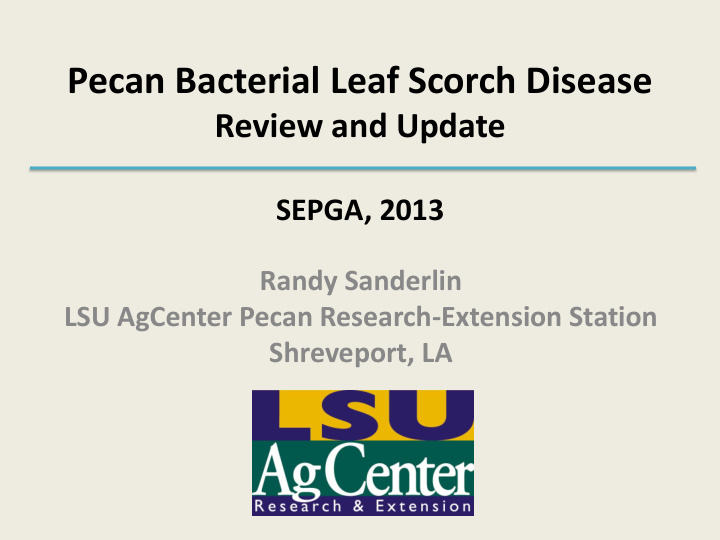



Pecan Bacterial Leaf Scorch Disease Review and Update SEPGA, 2013 Randy Sanderlin LSU AgCenter Pecan Research-Extension Station Shreveport, LA
Pecan bacterial leaf scorch (PBLS) caused by bacterium Xylella fastidiosa that lives in the water and nutrient conducting tissue of plants it infects
PBLS symptoms begin at edges and near tips of leaflets, tan coloration
Leaflets drop leaving bare leaf stems Repeated annual defoliation can result in dead branches
Effect of PBLS on Yield and Tree Growth % Reduced % Reduced % Leaflet Kernel Weight Terminal Defoliation Weight Year 1 19 29 67 Year 2 16 32 66 Year 3 14 20 41 Average 16.3 27 58
Effect of PBLS on Early Tree Growth % Reduced Height % Smaller Diameter 4-year-old 40 43 trees 9-year-old _ 52 trees
Cultivar Susceptibility To Scorch Disease Difficult to Categorize – Variation within Individual Cultivars • Cape Fear • Cheyenne • Oconee • Sumner • Pawnee • Desirable • Forkert • Moreland • Elliott • Stuart • Candy
Insect Transmission in Pecan • Insect transmission ranged from 2 – 100% depending on the species of insect Johnsongrass sharpshooter Lateral-lined sharpshooter Pecan spittlebug Glassy-winged sharpshooter Diamond-backed spittlebug Photo by: R. Melanson Photos by: S. Gil
Pecan Spittlebug Adult Glassy-winged Sharpshooter (GWSS) Photo by: Rebecca Melanson GWSS about 0.5inch long GWSS feeding on pecan stem
GWSS On Pecan Observed feeding in large numbers on pecan, prefer succulent growth
Certain plants attract the glassy-winged sharpshooter, including peach, plum, citrus, crepe myrtle
Graft-Transmission of the PBLS Pathogen • Occurs with infected scions (21%) or rootstocks (85%) • Can introduce disease into a new orchard • Manageable: – Observe potential sources of stocks & scions during late summer for PBLS. – Avoid using diseased trees for graft sources. • Treat scions with hot water to eliminate pathogen: 115 ° F for 30 minutes.
Current Work • Five subspecies of X. fastidiosa are recognized. Subspecies are identified by genetic differences and host specialization. • Rebecca Melanson in her MS work determined that the strain of XF that infects pecan is subspecies multiplex. • Recent results suggest that there may be additional host specialization within multiplex .
Current Objective • To determine if the pecan strain can infect other hosts of X. fastidiosa. • Why? Information about pecan strain host range could be useful in disease management
X. fastidiosa from pecan is grown in lab culture
Suspension is made from culture and used to inoculate plants by placing suspension drops on main plant stem
Plant absorbs bacterial suspension when needle is passed through drop and into plant
Infection determined by symptoms (two months to a year) and serological test
Pecan X. fastidiosa sp. multiplex Host Range Test Host Percent of plants Infected by inoculation 2008 2009 2010 2011 Pecan 80 50 0 85 Plum 0 0 0 0 Sycamore 0 0 0 0 Blueberry - - 0 0 Red Maple 0 0 0 0 Grape 0 0 0 0 Oleander 0 0 0 0
Preliminary Results • Pecan may have a limited host range • Very difficult to establish a negative hypothesis in biology – always exceptions to the rule • Additional testing is needed before conclusions can be made about the host range of pecan XF • The 2011 and 2012 test plants will be tested with a more sensitive assay for XF • Need to determine if XF strains from other plants can infect pecan
Acknowledgements • Rebecca A. Melanson – LSU Department of Plant Pathology and Crop Physiology, Baton Rouge, LA • Stephanie Gil – LSU Department of Entomology, Baton Rouge, LA • Mike Hall – LSU AgCenter Pecan Research-Extension, Shreveport, LA • Bill Ree – Texas A&M AgriLife Extension, College Station, TX • Forrest Mitchell – Texas A&M AgriLife, Entomology, Stephe nville, TX
Recommend
More recommend